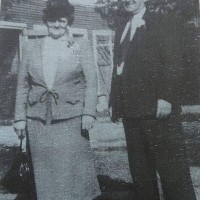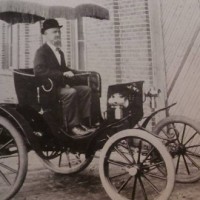Molly Crusen Bishop: My grandpa witnessed history
- Details
- Published on Saturday, 03 June 2017 17:56
- Written by Molly Crusen Bishop
There were two guys named Charles living on Barker Avenue on Peoria’s West Bluff in the 1890s. One was Charles Duryea, the father of the American automotive industry, and the other m was my grandfather, Charles Needham.
Charles Needham was born in Peoria in the early 1880s to Patrick and Ellen McGowan Needham, first generation Irish Catholics. Patrick worked for the Rock Island Railroad Line.
Charlie Needham attended a school originally called the Fifth District School on Moss Avenue. It was later called Franklin, though not the Franklin on Columbia Terrace. The first Franklin/Fifth District School on Moss was authorized by the Peoria District School Board in 1853, with the school being completed the following year.
Charlie Needham describes attending in 1890 at an old-looking school of eight to 10 rooms. It had wooden walkways to it and around it and each room was heated by a large coal-burning stove. Toilet facilities were located about 300 feet behind the school. The Franklin school on Columbia was built around 1892, and the old Franklin on Moss Avenue had its name changed to Columbia. It was later torn down to build the Washington school, which is now a Buddhist temple.
Charles Duryea was born in 1861 near Canton, Illinois. He and his brother Frank were originally involved in bicycle manufacturing. Frank was already in Peoria when Charles arrived in 1892 to launch a bicycle he had designed and for the brothers to work with the Rouse-Duryea Company.
The brothers co-founded the Duryea Motor Wagon Company. Charles was the engineer of the first working American gasoline powered automobile, and my grandpa Charlie Needham witnessed this first hand as a young boy.
“Speaking of automobiles, I might add that Charles E. Duryea, was given credit as the inventor of the first usable automobile, resided at the time he worked on his first car at [then} 208 Barker Avenue, and worked on his machine in his ‘barn’ as in those days we didn’t have garages, we had barns. I saw Charles Duryea test driving his horseless wagon up and down Barker Avenue trying it out,” Charlie Needham.
Charles and Frank Duryea successfully crafted the gasoline powered three-wheeled, three-cylinder horseless carriage known as the Peoria Motor Trap, test driving it up and down Barker Avenue on Peoria’s West Bluff. In 1898, Charles developed the Duryea Manufacturing Co. in Peoria Heights with plans to mass produce the vehicles. About 13 traps were built when the company began to have financial problems and went out of business. The brothers ultimately went their separate ways, creating separate companies.
Charles and Frank had a long public dispute on who should get credit for inventing the gasoline powered automobile. Charles Duryea claimed himself as the “Father of the American Automotive Industry.” One of their early automobiles is in the Smithsonian Museum. Another one was bought by a group called “Bring Home The Duryea” to Peoria in 1992, after raising the $125,000 dollars to purchase from a private owner. The Duryea trap was located in the downtown library in Peoria until it was brought to the Peoria Riverfront Museum in 2012.
Charles Duryea died in 1938 and my grandfather Charles Needham died in 1957, long before my birth in 1972. I was raised in the house on Barker Avenue from which my grandpa witnessed history in the making: The house Charles Duryea built and test drove his horseless carriages from is now 1512 W. Barker Avenue, and is for sale, incidentally.
I will write about another event in local history next week called The West Bluff Water Tower Disaster. This story includes my grandpa Charlie and life-altering events he endured as a boy on the west bluff of Peoria on March 30, 1894.




















































